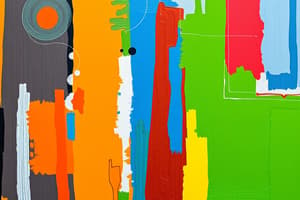Podcast
Questions and Answers
Which of the following best defines tertiary colours?
Which of the following best defines tertiary colours?
- A primary colour mixed with an adjacent tertiary colour.
- All colours achieved by adding white to the primary colours.
- A primary colour mixed with an adjacent secondary colour. (correct)
- Two primary colours blended together.
What is the primary purpose of the modern colour wheel?
What is the primary purpose of the modern colour wheel?
- To provide a guide for creating complex patterns in visual art.
- To show the different shades of black and white.
- To create a visual representation of how colours can be used in clothing design.
- To explain how colour is arranged and how colours interact with one another. (correct)
What does the art element 'value' refer to?
What does the art element 'value' refer to?
- The emotional response evoked by the use of certain colours.
- The brightness or darkness of a colour determined by light reflection. (correct)
- The way different shapes are arranged within a piece of art.
- The overall saturation of a colour in relation to another.
Which element of art primarily guides the viewer's eyes across a canvas?
Which element of art primarily guides the viewer's eyes across a canvas?
What are the principles of art concerned with?
What are the principles of art concerned with?
What role does 'space' play in visual art?
What role does 'space' play in visual art?
What does 'pattern' refer to in the context of art?
What does 'pattern' refer to in the context of art?
Which element of art provides the structure and volume in a piece?
Which element of art provides the structure and volume in a piece?
Flashcards are hidden until you start studying
Study Notes
Elements of Art
- Seven elements of art: colour, value, line, form, shape, space, texture.
Colour Wheel
- The modern colour wheel explains the arrangement of colours and their interactions.
Primary Colours
- Primary colours include red, yellow, and blue; these are the foundational colours that cannot be created by mixing other colours.
Secondary Colours
- Secondary colours are formed by mixing two primary colours together.
Tertiary Colours
- Tertiary colours result from mixing a primary colour with an adjacent secondary colour.
Value
- Value refers to the lightness or darkness of a colour, affecting how it appears when black or white is added.
Form
- Form provides three-dimensional shape to a piece of art, contributing to its overall structure.
Line
- Line is an invisible force guiding the viewer's eyes across the canvas, enhancing composition.
Space
- Space is the area around the focal point in an artwork, impacting visual emphasis and depth.
Principles of Art
- Key principles of art include balance, contrast, rhythm/movement, proportion/scale, pattern, unity, and variety.
Contrast
- Contrast is the difference in colours used to create visual interest and distinction in art.
Pattern
- Pattern refers to the organization and repetition of shapes or forms within a piece.
Responding to Art
- Steps to answer a question about art:
- Observe the image.
- Identify where art elements and design principles are applied in the image.
- Propose an opinion based on observations.
Studying That Suits You
Use AI to generate personalized quizzes and flashcards to suit your learning preferences.




